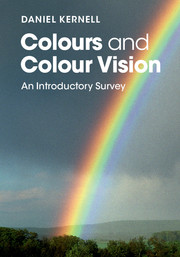Book contents
- Frontmatter
- Dedication
- Contents
- List of plates
- List of figures
- List of tables
- Preface
- 1 Colour vision in everyday life
- 2 The signals of colours: light and wavelengths
- 3 Colours and viewing conditions: not only local wavelengths
- 4 Our biological hardware: eye and brain
- 5 Eyes with unconventional properties: the ‘red-green blinds’
- 6 Other kinds of unconventional colour vision
- 7 Colour vision in different species of animals
- Appendices
- Notes
- References
- Index
- Plate section
2 - The signals of colours: light and wavelengths
Published online by Cambridge University Press: 05 March 2016
- Frontmatter
- Dedication
- Contents
- List of plates
- List of figures
- List of tables
- Preface
- 1 Colour vision in everyday life
- 2 The signals of colours: light and wavelengths
- 3 Colours and viewing conditions: not only local wavelengths
- 4 Our biological hardware: eye and brain
- 5 Eyes with unconventional properties: the ‘red-green blinds’
- 6 Other kinds of unconventional colour vision
- 7 Colour vision in different species of animals
- Appendices
- Notes
- References
- Index
- Plate section
Summary
This chapter will deal with the peripheral mechanisms of colour: which are the characteristics of the physical phenomena that our eyes and brains interpret as ‘colours’? As a starting point, it is evident that colours in our surroundings are dependent on light: in darkness we generally see no colours, and the colour of an object can clearly be influenced by the characteristics of the illumination. Thus, for an analysis of colours and colour vision, it is necessary to know more about how varying characteristics of light might influence our sense organs and visual perception. This is a complex subject and the knowledge and insights concerning these matters have been gradually growing during a long period of time. The key concepts concerned are illustrated in a very concrete manner, I think, by considering the progress in this field historically, including a description of some crucial early experiments; this will be done in part of the present chapter.
It is, in this context, important to keep remembering that colours are experiences of conscious brains; as Newton pointed out ‘the rays are not coloured’. Colours do not, in themselves, have an independent existence but we see particular colours when lights of appropriate characteristics enter our eyes. Thus, when we talk about a light as being ‘blue’ or ‘yellow’, this is a simplified way of saying that the light in question has characteristics that most human observers would perceive and interpret as being ‘blue’ or ‘yellow’.
Light and darkness: early thoughts concerning the nature of colours
In the ancient world, the sense of vision was interpreted using models which now seem highly exotic. It was believed that, somehow, portions of the observed objects physically entered the eyes and gave rise to the perception. It was sometimes suggested that some kind of rays emerged from the eye itself to cause the correct capture of the necessary ‘layers’ of surrounding objects. Colours were believed to emerge from mutual interactions between light and darkness. Nowadays, darkness is essentially thought of as an absence of light. In the ancient world, darkness was instead believed to have a positive existence of its own, like some kind of black soup that might be mixed, in various proportions, with the white soup of light.
- Type
- Chapter
- Information
- Colours and Colour VisionAn Introductory Survey, pp. 36 - 73Publisher: Cambridge University PressPrint publication year: 2016



